<< Previous section: Introduction | Main Table of Contents | Next section: Specific Guidelines >>
Table of Contents for General Guidelines Section
A. Style and Language
B. Formatting and Layout
2a. Images Spanning Multiple Pages
Style and Language:
1. Context is Key
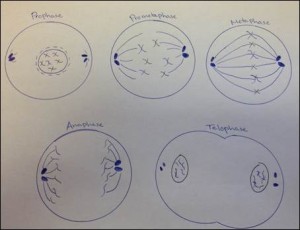
Guidelines:
- Descriptions for the same image may differ vastly depending on context.
- Survey the text surrounding an image to understand how it fits into the bigger picture.
- Use context to decide which basic concepts and terms have already been explained, and avoid repetition of explanations.
- Use the following questions to decide which key elements of an image are needed to understand the content:
- Is it part of an introduction for a chapter or lesson? If so, the image probably isn’t teaching a concept and may not need to be described in detail.
- Is it the central point of a lesson? If so, the image is a critical part of the learning concept and should be described as thoroughly as possible.
- Is it purely decorative? If the image does not teach anything, describe it as a decorative image and avoid sharing irrelevant information.
- Is it part of an assessment or activity? If so, be sure to describe the specific pieces of information needed to complete the task.
- Is an action required? When a figure contains additional links or represents an activity (e.g. pencil icon represents a writing exercise, headphone icon represents a listening exercise), highlight the functional role to facilitate navigation.
Description:
Mitosis stages: Prophase, Prometaphase, Metaphase, Anaphase, and Telophase.This image in context:
- This illustration is from the chapter summary of a biology textbook. It is accompanied by an exercise where students are expected to answer the following question regarding the series of steps depicted in the drawings: Which of the following is not typically described as one of the four main stages of Mitosis? Where, in mitosis, is that process likely to be covered?
- A detailed description of what each stage looks like is not needed because this is an exercise in a chapter summary, and it does not need to recap basic concepts.
Return to main table of contents | Return to top of page | Next
2. Consider your Audience

Guidelines:
- Know your target reader (e.g. age, culture, subject-matter expertise).
- Use vocabulary and phrases appropriate for the reader.
- Reference examples and details that the reader will understand (this includes objects and attributes used in the description).
Description:
This is a photograph of the Louvre Museum in France at night. The entrance to the museum is a large pyramid made out of glass.This image in context:
- This photograph of the Louvre is part of an introduction to a chapter in a history textbook for young children.
- The description uses language and introduces shapes appropriate for a young child.
Return to main table of contents | Return to top of page | Next
3. Be Concise
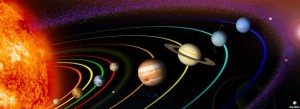
Guidelines:
- More is NOT better – be succinct.
- Don’t repeat information presented in the main or adjacent texts. Instead, direct readers to existing descriptions, when available (e.g. captions).
- Include color only when it is significant (e.g. arbitrary colors assigned for elements of bar graphs and line charts need not be specified).
- Avoid introducing new concepts or terms.
Description:
Figure 1.1.This Image in context:
- This photograph and caption are from a fifth grade science textbook in a section about our solar system.
- The accompanying caption provides sufficient information about the photograph, so readers should be directed to the existing text.
- While this image is very colorful, describing the color of the orbiting paths for example would be excessive and not necessary for understanding the concept of orbital paths.
Return to main table of contents | Return to top of page | Next
4. Be Objective

Guidelines:
- Describe only what you see – physical appearances and actions rather than emotions and possible intentions.
- Don’t interpret or analyze the material. Instead, allow readers to form their own opinions.
- Don’t omit uncomfortable or controversial content, such as images associated with politics, religion, or sex.
Description:
A puffin bird with white liquid projecting from its tail end stands on a rocky mound covered by white excrement.This image in context:
- This photograph is found on a geology website discussing various events that lead to the acid erosion of rock formations over time.
- This description quickly identifies the puffin as a bird for those who may not be familiar.
- The description states the bird’s current status and objectively presents defecation as a likely cause of acid erosion.
Return to main table of contents | Return to top of page | Next
5. General to Specific

Guidelines:
- Start with high-level context, and then drill down to details that enhance understanding. This provides the reader with options about how much information to read.
- Segment content into logical, digestible chunks.
Description:
A map of the United States made out of recycled license plates. This “recycled map” is about five feet wide, with each state represented by license plate cutouts from the respective state. Large states such as Texas and California are made of one or more colorful metal license plates while smaller New England states are represented by just a few inches of their license plates.This image in context:
- This map is found in an art history book in a section that introduces the concept of using recycled materials to produce art.
- The description starts with high-level context about the “recycled map,” and then provides readers with the option to drill-down and learn more about the collage.
Return to main table of contents | Return to top of page | Next
6. Tone and Language
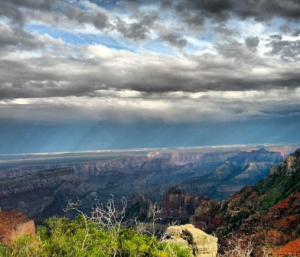
Guidelines:
- Use active verbs in the present tense.
- Check spelling, grammar, and punctuation. Sometimes it is acceptable to break traditional grammar rules for brevity and clarity. However, it is important to be consistent in this practice.
- Apply the same writing style and terminology as the surrounding text.
- Write out abbreviations and symbols to ensure proper pronunciation by screen readers.
- Use descriptive vocabulary that adds meaning (e.g. “map” instead of “image”).
Description:
A photograph of a blue sky peeking through grey storm clouds over the Grand Canyon in early September.This image in context:
- This photograph of the Grand Canyon was taken in early September, which is Arizona’s monsoon season. It appears in a book about national parks in the United States.
- The photograph accurately captures the tone of the scene. After hearing about the “violent” storm in the text that precedes the image, the use of “peeking” to describe the blue sky creates the right tone.
- The description avoids the use of abbreviations such as “Sept.” to ensure proper reading by screen readers.
- While the description is an incomplete sentence, it is clear and brief, which ultimately benefits the student.
Return to main table of contents | Return to top of page | Next
Formatting and Layout:
1. Insets
1a. As Graphs
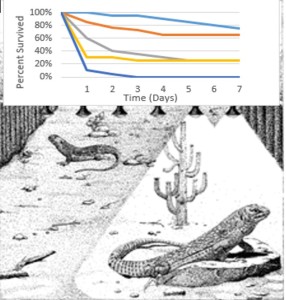
Guidelines:
- Give a brief overview of the picture, i.e., a basic illustration with an embedded graph, and then provide the detail.
- Avoid describing extraneous visual information, ex., one lizard is perched on a rock, there are six lamps on a beam.
- Determine if the graph can be sufficiently summarized in a sentence or two. If not, provide the data in a table with row and column headings.
- In the graph there are numbers in parentheses that are not explained in the caption or the surrounding text. They should not be ignored in the description. Include them but do not guess at or assume their meaning.
Description
A drawing shows two lizards in a confined space. One lizard stands in a shadow, and the other lizard stands beneath a heat lamp. Above the lizards is a multiple line graph. The horizontal X axis is labeled “time (days).” The vertical Y axis is labeled “% survived.”In the graph there are five separate lines labeled by temperature ranging from 34°C to 42°C and followed by another number in parenthesis. The graph is represented by the following table. All data are approximate.| Degrees Celcius | 1 Day | 2 Days | 3 Days | 4 Days | 5 Days | 6 Days | 7 Days |
|---|---|---|---|---|---|---|---|
| 42°C (24) | 100% | 95% | 95% | 90% | 85% | 80% | 75% |
| 40°C (12) | 85% | 77% | 73% | 65% | 65% | 65% | 65% |
| 38°C (36) | 60% | 40% | 35% | 30% | 25% | 25% | 25% |
| 36°C (12) | 30% | 30% | 25% | 25% | 25% | 25% | 25% |
| 30°C (12) | 10% | 5% | 0% | 0% | 0% | 0% | 0% |
Return to main table of contents | Return to top of page | Next
1b. As Images
Guidelines:
- Identify type of map and area covered.
- Calling out the insets separately is not necessary. Instead, identify inset images and relevance.
- Identify labels and legend/key. In some cases, color or icons in a key may be important, but they are not in this particular case.
- Use a bulleted list if there are many pieces of information. See Description 1.
- A narrative may be used if a general understanding is intended rather than specific information. See Description 2.
Description 1:
- The Knobs Region: a photo of a typical “knob” mountain, rising to a tall point;
- Western Kentucky Coal Field Region: a photo of a bridge spanning the Ohio River;
- Mississippi Embayment Region: a photo of a swamp with trees growing along the edges.
- A map key shows symbols to indicate highest point, lowest point, mountain peak, natural region border, sub-region border, and state border.
Description 2:
A map highlighting various regions of Kentucky shows 3 photos of different regions. The Knobs Region: a photo of a typical “knob” mountain, rising to a tall point. The Western Kentucky Coal Field Region: a photo of a bridge spanning the Ohio River. Mississippi Embayment Region: a photo of a swamp with trees growing along the edges. A map key shows symbols to indicate highest point, lowest point, mountain peak, natural region border, sub-region border, and state border.The image in context:
- This image is used at the beginning of the section discussing regions of Kentucky.
- In this context, the student only needs to hear about the different types of regions and the navigability of bullets is not needed. Description 2 is the best fit.
Return to main table of contents | Return to top of page | next
1c. As Keys and Legends
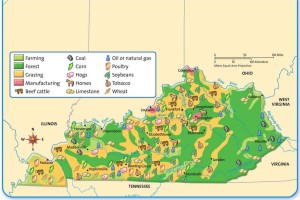
Guidelines:
- Identify type of map and area covered.
- Identify labels and legend/key.
- List text in legend that corresponds to picture on map.
- In some cases, color or the actual pictures in a key may be important. In this case, they are not.
Description:
A Kentucky land-use map. A key shows pictures of the following industries: farming, forest, grazing, manufacturing, beef cattle, coal, corn, hogs, horses, limestone, oil or natural gas, poultry, soybeans, tobacco and wheat. The pictures are scattered across the map. The west and center of the state shows more grazing and the east shows more forest.Return to main table of contents | Return to top of page | Next
1d. As Text
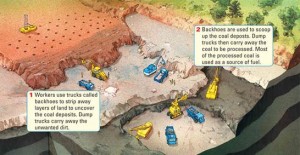
Guidelines:
- Describe the picture first for context and to set up for the inset text.
- The inset text may not need to be called out separately but can be incorporated seamlessly into the description.
- If surrounding text and captions contain the inset text, describe the picture only. See Description 1.
- If the surrounding text does not contain the inset text, use Description 2.
Description 1:
An illustration shows a strip mining operation. A huge hole has been dug into the ground, big enough for trucks to drive on different layers down to the bottom of the hole.Description 2:
An illustration shows a strip mining operation. A huge hole has been dug into the ground, big enough for trucks to drive on different layers down to the bottom of the hole. First, workers use trucks called backhoes to strip away layers of land to uncover the coal deposits. Dump trucks carry away the unwanted dirt. Next, backhoes are used to scoop up the coal deposits. Dump trucks then carry away the coal to be processed. Most of the processed coal is used as a source of fuel.This image in context:
- This illustration is used at the beginning of the section to introduce the topic.
- The caption and text describes the image and the inset text, so Description 1 is a good fit.
Return to main table of contents | Return to top of page | Next
2. Layout and Formatting
2a. Images Spanning Multiple Pages

Guidelines:
- Sometimes an image spans the left page and the right page (across the gutter). Although this appears as a single image in the book, it is actually two separate images. Poet and screen readers will discover these as separate images (often times separated by text and other images). To avoid confusion, describe the entire image in the description of the first image (typically the left hand image) and label the second image (typically the right hand image) as decorative so that a screen reader will skip over it.
Description for top panel:
A timeline titled, “Kentucky’s Geography and Early People.” About twelve thousand five hundred years ago, people arrive in what is now Kentucky, page 33. About ten thousand years ago, people in southwestern Asia begin to grow crops and raise animals. Also about ten thousand years ago, Archaic Indians begin to barter for materials to make tools. Page 34. About six thousand two hundred years ago, the Egyptians develop a calendar. About five thousand five hundred years ago, the earliest cities form in southwestern Asia. About four thousand years ago, Native Americans begin to settle in villages in what is now the western United States. About three thousand years ago, native Kentuckians start growing corn and beans, page 35. About one thousand six hundred years ago, Christianity becomes the official religion of the Roman Empire. About one thousand years ago, Mississippians build mounds in what is now Kentucky, page 36.Description for bottom panel:
Decorative.The image in context:
- This image is the opener for a unit on time.
- The caption provides the timeline information, so in this case, the entire image (both the left and right sides) is decorative.
<< Return to main table of contents | Return to top of page | Next (Specific Guidelines) >>


